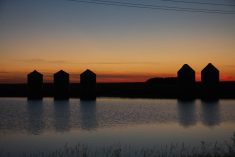Crop Production Week in Saskatchewan this year was interrupted with a wild storm that swept the Prairies. Out of this storm came many stories, most of which provide us with an opportunity to learn, or be reminded of the necessity of preparing ourselves for the winter elements.
Growing up on the Prairies, we learned that if we were ever stranded on the road in a storm, never leave the vehicle. Someone will come along eventually, and you will be safe until then.
We also learned to store extra clothes and outer gear, an emergency kit with candles, matches, flashlight, chocolate bars or some other food in an emergency bag. We learned to cover our heads and feet to keep warm, since 60 percent of heat loss is through our heads. We also learned to keep our gas tank full during the winter and to have extra windshield washer fluid and gas-line antifreeze on hand.
Read Also

Know what costs are involved in keeping crops in the bin
When you’re looking at full bins and rising calf prices, the human reflex is to hold on and hope for more. That’s not a plan. It’s a bet. Storage has a price tag.
During the storm, our car was parked outside and although it started the next morning, as soon as I tried to get going, it would shut down. Gas-line antifreeze got me on the road. Be sure to read the labels, since the larger container I took in the car, and thankfully did not use, was antifreeze, not gas-line antifreeze.
However, it has been a long time since we have had a rip-roaring storm, and we easily forget. Many of our children have grown up here without experiencing such a storm and the rest of us have forgotten how dangerous this can be. However, nature has its own way of reminding us of our vulnerability.
Are you prepared? What do you have in the line of emergency kits in your vehicles?
The Canadian Automobile Association recommends the following items be kept in the trunk of your car: shovel, sand or cat litter, traction mats, tow chain, compass, cloth or roll of paper towels, warning light or road flares, extra clothing and footwear, emergency food pack, booster cables, ice scraper and brush, matches and a “survival” candle in a deep can (to warm hands, heat a drink or use as an emergency light), fire extinguisher, extra windshield washer fluid and fuel-line antifreeze.
It is also a good idea to keep a cell phone, blanket, flashlight, first-aid kit, matches, candles and food items in the front of cab of the vehicle. We keep an old bag phone (no pun intended) in our car for emergency use. The downside of the bag phone is that the motor needs to be running for the phone to work.
If you must travel during a winter storm, do so during the day and let someone know your route and arrival time. If you must stop, pull off at an approach or off the road as far as you can to the right to avoid being hit by traffic.
If your car gets stuck in a blizzard or snowstorm, remain calm and stay in your car. Allow fresh air in your car by opening the window slightly on the sheltered side, away from the wind. You can run the car engine about 10 minutes every half-hour if the exhaust system is working well.
Beware of exhaust fumes and check the exhaust pipe periodically to make sure it is not blocked with snow. Remember: you can’t smell potentially fatal carbon monoxide fumes.
To keep your hands and feet warm, exercise them periodically. In general, it is a good idea to keep moving to avoid falling asleep. If the car is running and the radio is on, car dancing can help you stay warm, but do not overexert yourself. It is best to stay in the car to keep warm, but if you do try to shovel the snow from around your car, avoid overexerting yourself, as shovelling and bitter cold can kill.
Watch for traffic or searchers. Keep your interior dome light on and your four way flashers on when the vehicle is running.
It is times like this (storms and wintry weather) that make us appreciate the people in our lives. We are thankful for telephones to communicate with others to be sure they have safely arrived at their destinations.
We spend time reflecting on what it must have been like for early settlers to be waiting out a storm. It is a night to leave the outside lights on in case someone is out in the storm.
Source: Canadian Automobile Association.
Recipe for life
This is also a good time to reflect on the resolutions made at the beginning of this year, what is most important in life, what values take priority, and what matters most. Taking time to be conscious of how our time is spent on this earth is time well spent.
Sorting through some treasures I have collected over the years, I found this anonymous work that sums up what my resolutions at this stage of the family life cycle look like:
Recipe for contentment
- Take time to work – it is the price of success.
- Take time to think – it is the source of power.
- Take time to play – it is the secret of youth.
- Take time to read – it is the foundation of knowledge.
- Take time to be spiritual – it is the highway of reverence.
- Take time to help and enjoy friends – it is the source of happiness.
- Take time to love – it is the substance of life.
- Take time to dream – it hitches the soul to the stars.
- Take time to laugh – it is the singing that helps with life’s loads.
- Take time to plan – it is the secret of being able to have time to take time for the first nine things.
Recipe wanted
Dear TEAM: I would like you to send me the recipe for wheat salad. – B.G., Islay, Alta.
Dear B.G.: Here is a wheat salad recipe that we published several years ago. Perhaps some of our readers have tried and enjoyed it.
Wheat Salad
2 cups wheat 500 mL
8 ounces cream cheese 250 g
2 tablespoons lemon juice 30 mL
1 package (3.5 oz.) vanilla 100 g
instant pudding
1 can (14 oz.) crushed 398 mL
pineapple, drained
2 cups dessert topping 500 mL
Soak wheat in water overnight. Rinse with cold water, then cook in water over low heat until soft, about three or four hours. Drain. Rinse with cold water.
Combine softened cream cheese, lemon juice, pudding and pineapple, mixing well. Add cooked wheat. Just before serving, add dessert topping. Serves eight to 10.
For a creamier salad, use a large six ounce (170 g) package of instant pudding and/or a large (1 L) tub of dessert topping.
Source: Cooking Collections, Canadian Feasts from Land and Sea by Federated Women’s Institute of Canada, Centax Books.
Barbara Sanderson is a home economist from Rosetown, Sask., and one of four columnists comprising Team Resources. Send correspondence in care of this newspaper, Box 2500, Saskatoon, Sask., S7K 2C4 or contact them at team@producer.com.














